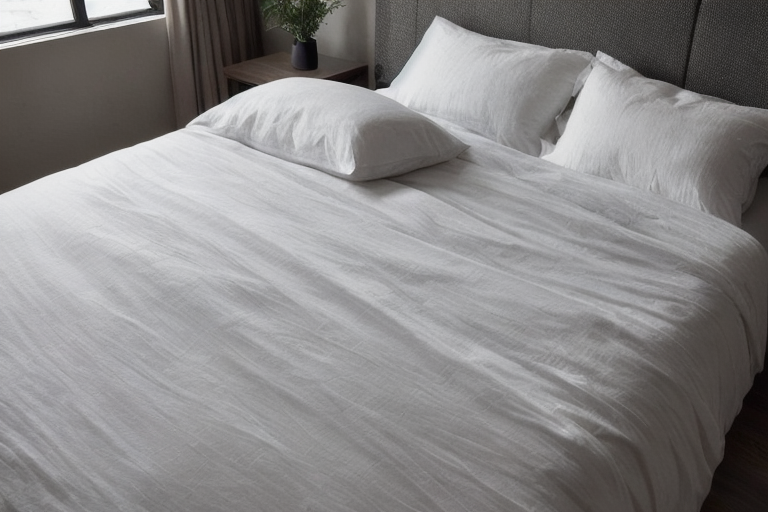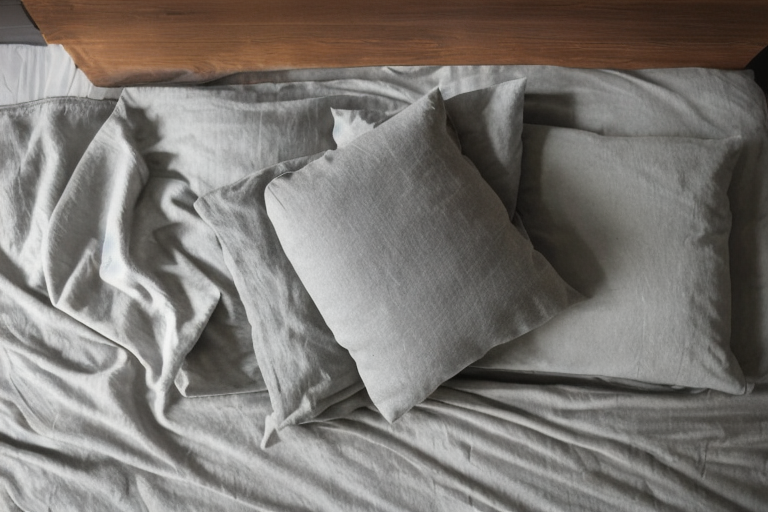When it comes to creating a cozy, welcoming sleep space, choosing the right bedding is key. But navigating the world of duvets, comforters, thread counts, and fill powers can quickly get confusing, especially for beginners. If you’ve ever wondered what the difference is between a down comforter and a duvet, you’re not alone!
This beginner’s guide will walk you through everything you need to know when deciding between these two popular sleep essentials. We’ll compare the construction, materials, care instructions, costs, and benefits of down comforters and duvets so you can determine which is best for your bedroom decor and sleep comfort.
Whether you tend to sleep hot or cold, struggle with allergies, or simply want to up your bedding game, read on for tips to help choose the perfect down comforter or duvet for your needs!
Down Comforters and Duvets 101
Before we dive into the details, let’s clearly define what exactly down comforters and duvets are:
- Down comforter: A one-piece bed cover filled with insulation like down, feathers, or down alternative materials. It is the standalone top layer and designed to provide warmth to the sleeper.
- Duvet: A soft flat bag often filled with down or feathers and used with a duvet cover. It serves as insulation just like a comforter but isn’t the outermost bed layer.
A common misconception is that a duvet and comforter serve the same purpose. While both provide cozy warmth for sleep, a duvet relies on a duvet cover to act as the decorative exterior, whereas the comforter is the finished product.
Below, we’ll explore these two bedding staples in-depth so you can learn how to choose which is best for your sleeping needs!
Comfort and Insulation Comparison
One of the main purposes of both comforters and duvets is promoting comfortable sleep through insulation that traps body heat. Let’s see how they stack up when it comes to warmth.
Fill Power Matters
The insulation powers of down bedding depend largely on fill power. This indicates the “fluffiness” and quality of the down fill material inside.
- Higher fill powers (600-900+) provide superior warmth
- Lower fill powers (under 600) don’t insulate as well
Most quality down comforters and duvets will have a fill power over 600. This leads to better circulation of fill and traps more warm air.
Baffle Box Design
Another important factor is baffle box construction which contains down in evenly spaced fabric pockets:
- Prevents the fill material from clumping/shifting
- Allows for consistent warmth distribution
- Seen more in higher end down comforters and duvets
Overall, both comforters and duvets can provide exceptional warmth for sleep when made well. Pay attention to fill power and construction to determine insulation abilities!
Down vs. Down Alternative
For optimal warmth, most experts recommend goose down which lofts better than lower quality duck feathers. That said:
- Goose down is more expensive
- Allergy sufferers may need a hypoallergenic down alternative like polyester
- Synthetic fills vary widely in quality and performance
Consider your budget, health factors, and ethical concerns when choosing fill materials. Down alternative comforters can still provide cozy comfort for sleep!
Adjusting for Seasons and Temperatures
- Lightweight comforters work well for warmer weather
- All-season comforters transition between temperatures
- Adjust bedding layers as needed to prevent overheating/chills
Don’t be afraid to switch up your down bedding by season! Having options ensures ideal sleep temperature year-round.
Construction Quality Comparison

How down comforters and duvets are constructed also affects their performance. Here are key factors to consider:
Superior Fill Materials
In addition to down and feathers, some quality sleep products use luxury fill materials like:
- Silk – extremely breathable and moisture-wicking
- Wool – natural temperature regulator, moisture resistant
- Cotton – beloved for its breathability and durability
High end bedding may also advertise special enhancements like:
- Antimicrobial Nanotex® treatment
- Balanced silk and cotton mixes
This improves functions like moisture control and heat distribution for better sleep.
Design Techniques Matter
There are two main construction techniques used:
- Baffle box (best)- keeps insulation evenly distributed through fabric walls
- Sewn-through – stitching goes all the way through, can shift fill around
Baffle boxes tend to provide better warmth circulation. Details like reinforced seams also signal durability and care was taken in manufacturing.
- 300-600+ thread count cotton shells offer superior breathability
- Look for mentions of special weave styles like damask stripes, gingham check, or jacquard which impact texture
A final construction note – density matters too! Plush bedding with more ounces of fill per square inch means more luxury.
Certifications Signal Safety + Ethics
Reputable brands declare certifications confirming:
- Safe, non-toxic materials (OEKO-TEX®)
- Ethical down sourcing standards (RDS)
- Thorough cleaning/sterilization (UltraCleanTM)
Certifications offer peace of mind about quality and care was taken in production.
Key Differences Between Duvets and Comforters
Now that we’ve covered construction and materials, let’s clarify the fundamental variations between these two bedding staples:
Decorative Outer Layer
- Comforters have a sewn decorative cover as the outer fabric
- Duvets rely on a removable duvet cover for aesthetics
This allows you to easily change the look of your bedding by swapping out duvet covers. It also simplifies cleaning needs.
Bedding Layers
While comforters take the place of a flat sheet as your top bed layer, duvet + cover combos lie underneath:
- Fitted sheet > Flat sheet > Duvet insert + duvet cover
- A duvet alone would replace the flat sheet in this stack
So comforters function as standalone pieces, while duvets integrate as part of full bedding sets.
Weight Distribution
Related to the layering order, duvets need to be lightweight enough for use under additional covers. The duvet insert is meant primarily for insulation, not density.
Comforters can afford to be fluffier and pack more fill ounce-for-ounce without becoming burdensome to sleep under.
Year-Round Use Differs
- Lightweight duvets often work best for insulating year-round
- You may want multiple comforters for winter vs summer
Because duvets aren’t the outermost layer, their weight adjusts well across seasons. You simply add/remove bedding layers as needed.
Unique Benefits of Each
Beyond construction and functionality, what are the perks of choosing one over the other?
Easy Duvet Maintenance
Since duvets live inside removable, washable covers you just launder the decorative outer shell rather than the entire insert whenever it needs freshening up. This saves major hassle compared to airing out a giant comforter!
Style Flexibility
Duvets win when it comes to changing up your bedroom decor. Simply pick a new duvet cover to get an instant color/pattern update. No need to purchase totally new bedding.
All-In-One Comforter Convenience
For those who don’t want to fuss with bedding layers, comforters offer an easy standalone piece that’s your final top layer. Less adjustability but simpler for some sleepers!
Luxe Living
When it comes to indulgent, fluffy, breathable comfort, top-tier down comforters win. With baffle boxes and premium materials, they become sumptuous blankets perfect for snuggling into.
Here’s a quick comparison table of some pros and cons:
| Duvets | Comforters |
|---|---|
| ✅ Decorative cover versatility | ❌ Single outer fabric limits style flexibility |
| ❌ Multiple pieces to layer | ✅ All-in-one convenience |
| ✅ Year-round /seasonal versatility | ❌ May need multiple weights for different seasons |
| ❌ Lie underneath other bedding | ✅ Ultimate outer bed layer |
| ✅ Easy cover washing | ❌ Bulky for cleaning |
As you can see, duvets offer more flexibility and customization while comforters prioritize ease of use and indulgent comfort.
Caring for Down Duvets vs. Comforters

To keep your bedding fresh and functioning well for years to come, proper maintenance is key! Here are some best practices for cleaning and storing these sleep essentials:
Washing Guidance
- Check labels to confirm washing machine vs dry clean only
- Wash duvet covers frequently to avoid insert grime buildup
- Spot clean down bedding for small stains
Note: Repeated machine cycles can damage delicate baffle boxes over time.
Proper Drying Is Crucial
After washing, always tumble dry low and add a couple dryer balls to redistribute fill and restore fluff. Don’t hang dry! Moisture ruins down’s warming abilities.
Off-Season Care
During warmer months when heavy bedding isn’t needed, experts recommend storing it:
- In breathable cotton cases or mesh bags
- Avoiding direct sunlight
- In clean, pest-free spaces
Proper storage preserves insulation powers and prevents musty odors.
Following care instructions keeps comforters and duvets primed for nights of cozy comfort!
How To Select the Perfect Down Bedding
With so many factors that go into choosing a duvet, comforter, or bedding set, making the decision can feel overwhelming! Here’s a step-by-step guide:
Fill Power First
Consider your insulation needs. Do you sleep cold and want ultra plush warmth? Splurge on a baffle box comforter or duvet with high 600-900+ fill power. Prefer breathability? Stick to lighter, lower fill bedding.
Lifestyle Match
Think about whether a duvet or comforter best fits your routine. Will swapping out decorative covers motivate you to refresh bedroom decor? Do you need fuss-free, all-season ease? Tailor to your habits.
Budget Parameters
Bedding investment ranges widely from $50 budget picks to $1000+ luxury. With both down types, you tend to get what you pay for. But decent quality starts around $150-$200 for queen sizes. Set realistic spending caps based on materials you want.
Prioritize Preferences
There are no “right” answers – only what makes YOU comfiest! Pick synthetic fills over feathers for animal-free sleep. Seek out hypoallergenic options if you have allergies. Love ultra-soft luxury bedding? Splurge on high thread count Egyptian Cotton shells.
Shop Sleep Guarantees
Ease bedding worries with retailer perks like:
- Flexible return policies
- Free shipping
- Trial periods before finalizing
Brands want you to love what you choose! Take advantage of guarantees so there’s no stress if you need to exchange.
Here are two top rated options with unique perks to consider:
Brooklinen Down Comforter
- 700 fill power
- Baffle box construction
- Plush yet breathable
- 365 day trial period
Price: $$-$$$$ based on size
Buffy Cloud Duvet
- Made from 100% recycled materials
- Eucalyptus fill and outer shell
- Naturally resistant to dust mites
- 90 day free returns
Price: $$-$$$ based on size
Both excellent options depening on your priorities and budget!
Achieving Dreamer’s Delight
At the end of the day, we all want bedding that makes slipping under the covers an absolute dream. Hopefully this down comforter vs duvet guide distilled some of the key similarities and differences to consider when finding your perfect match.
While filling your cart with the most indulgent 800 fill power comforter or curating a cute duvet cover collection sounds tempting, don’t forget to factor in year-round practicality too. The right lightweight, medium, and **ultra warm **bedding is key for sound slumber during every season.
We covered a lot of ground when it comes to construction quality, convenient care, and cozy comfort factors. Just remember – there’s no “one size fits all” solution. Choose what best suits your personal lifestyle and sleeping comfort preferences. At least now you can rest easy knowing exactly how to pick between these two fabulous bedding essentials!
Frequently Asked Questions
What’s the difference between a duvet and down comforter?
A duvet is an insert filled with down, feathers or alternative materials that goes inside a duvet cover. The cover provides the decorative outer layer. Down comforters have insulation material sewn inside an outer shell that serves as the finished piece.
Should I get a comforter or duvet for my bed?
It depends on your priorities! Duvets allow you to easily change covers for bedroom decor refreshing. But comforters take away the hassle of layering bedding. Pick comforters if you want an all-in-one sleep essential, or duvets for more style flexibility.
How do I know if my comforter has enough fill?
Check the fill power which indicates fluffiness and insulation quality. Comforters around 600-800 fill power ensure cozy warmth without overheating. Higher numbers mean more fill ounces per square inch.
What fill is warmest in a down comforter?
For ultimate warmth, goose down provides superior insulation over lower quality feathers. It lofts higher to better circulate fill and trap heat. But quality duck feathers or down alternatives still warm well!
Should I get a lightweight or all-season comforter?
It depends on your sleep temperature preference. Hot sleepers or warmer climates suit lightweight options. If you battle cold or live where winters dip frigid, pick medium warmth or ultra-plush. Many now have features like moisture wicking breathability across seasons.
How often should I wash my down comforter?
Experts typically recommend dry cleaning down comforters every 2-3 years max to protect delicate baffle box stitching. Spot clean stains when needed. Wash removable duvet covers more often, about every 1-2 months depending on use.
What’s the best way to store a down comforter?
During warmer off-seasons, keep comforters in breathable cotton cases out of direct sunlight. Avoid attics or basements with excess moisture or possible pests. This protects fill materials and prevents musty odors so insulation powers last!








